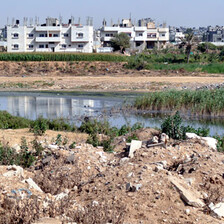The Electronic Intifada 17 September 2009

A pool of untreated sewage water in the northern Gaza Strip town of Beit Lahiya, September 2009. (Wissam Nassar/MaanImages)
RAMALLAH, occupied West Bank (IPS) - The International Committee of the Red Cross has warned that Gaza’s access to safe supply of drinking water could cease at any time. The World Health Organization (WHO) says outbreaks of disease could be triggered as a consequence.
The warnings follow a United Nations Environment Programme (UNEP) report Monday that “Gaza’s underground water system is in danger of collapse after recent conflict compounded by years of overuse and contamination.”
“An outbreak of Hepatitis A and parasitic infections could occur at any time,” Mahmoed Daher from WHO in Gaza told IPS. “Already the number of people, especially children, suffering from diarrhea has risen dramatically.”
“We have noticed an increase in people suffering from kidney diseases from water contaminated with toxins, as well as babies born with an unnatural blue tinge,” Munther Shoblak from Gaza’s Coastal Municipalities Water Utility (CMWU) told IPS.
The UNEP report focuses on a rise in saltwater intrusion from the sea caused by over-extraction of ground water, and pollution from sewage and agricultural run-off, with toxic levels high enough to put infants at risk of nitrate poisoning.
Gaza’s underground aquifer is the sole water source for its 1.5 million people. Only 5-10 percent of the water now is fit for human consumption.
The average per capita daily consumption of water for personal and domestic use in Gaza is 91 liters. WHO recommends 100-150 liters daily. Israelis consume 280 liters per day.
The UN Office for the Coordination of Humanitarian Affairs (OCHA) reported last week that at least 10,000 Gazans remain without access to the water network. Furthermore, access to water is limited on average to six to eight hours from one to four days a week for the entire population.
“Approximately 150-160 million cubic meters (mcm) are extracted from Gaza’s underground aquifer annually. Due to a regional drought over the last few years only about 65 mcm has flown back into the aquifer annually. This leaves a shortfall of 100 mcm,” says Shoblak.
Sewage-contaminated seawater and agricultural overflow contaminated with toxins have been flowing into the aquifer’s deficit. The CMWU is only able to partially treat some of the 80 million liters of sewage pumped out to sea on a daily basis due to a shortage of spare parts, fuel, and electricity cuts.
During Israel’s bombardment of Gaza during the December-January war, the strip’s already degraded infrastructure was heavily targeted.
CMWU estimates that about six million dollars worth damage was caused to major water and sanitation infrastructure during Operation Cast Lead, Israel’s code name for its war.
Over 30 kilometers of water networks were damaged or destroyed by the Israeli military in addition to 11 wells operated by the water authorities in Gaza. More than 6,000 roof tanks and 840 household connections were damaged.
There is an urgent need for cement, pipes, pumps, transformers and electrical spare parts to implement numerous projects in the water and wastewater sector.
Some 1,250 tons of cement are currently needed for the repair of water storage tanks alone. But Israel’s blockade prevents cement from being brought into Gaza.
Javier Cordoba, the ICRC water and habitation coordinator who is supervising Red Cross reconstruction efforts in Gaza says the situation is very fragile. “A lack of construction material and parts has led to a de-development of the water infrastructure, which could collapse at any minute,” Cordoba told IPS.
“The whole system is inter-connected,” Cordoba says. “Water wells use mechanical pumps to supply Gazan homes with water. The shortage of mechanical pumps and other spare parts has reduced the number of wells able to operate.”
Electricity shortages force the wells to rely on back-up generators. Israel’s blockade not only limits electricity supplies but the supply of industrial fuel too.
The ICRC has been working on ingenious methods to get around the blockade to bring temporary relief to Gazans.
“We have managed to build a new, albeit primitive, wastewater plant in Rafah in the south of Gaza. We used pieces of the wall which used to divide Gaza from the Sinai peninsula, before the wall was blown up last year, for the basic structure.
“We also succeeded in finding limited spare parts from Gaza to operate the plant,” said Cordoba. “But this is just an interim solution, and the well will only last about five years. The more permanent and sophisticated wastewater management plant in northern Gaza still requires imported parts from Israel.”
Cordoba added: “In order to relieve the pressure on the aquifer we have been digging a number of shallow wells. These again are only temporary and don’t supply much water like the deeper ones, but they allow the municipalities to function again.”
UNEP estimates that more than $1.5 billion may be needed over 20 years to restore the aquifer back to health, including the establishment of desalination plants to take pressure off the underground water supplies.
“The international community also has to fulfill its obligations in regard to economic pledges and promises it made to establish desalination and wastewater projects,” Shoblak told IPS. “Political pressure needs to be applied to Israel to allow for reconstruction and repairs.”
The UNEP report warns: “Unless the degradation trend is reversed now, damage could take centuries to reverse.”
All rights reserved, IPS - Inter Press Service (2009). Total or partial publication, retransmission or sale forbidden.





